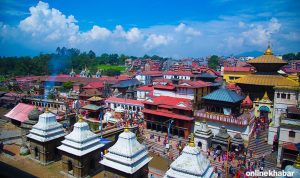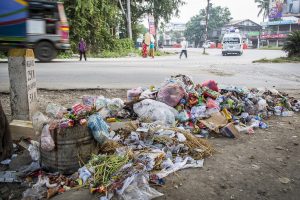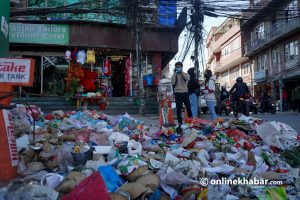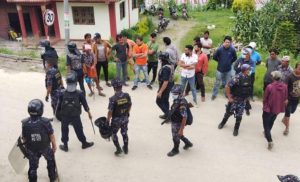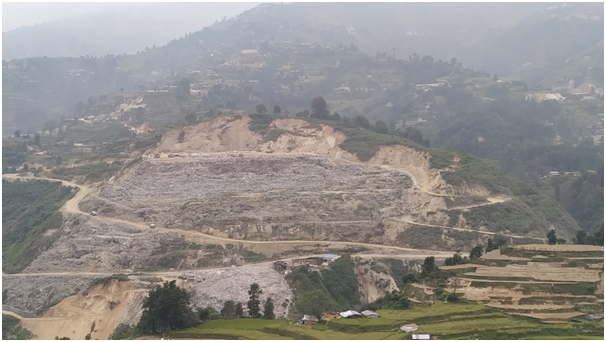
With the growing urbanisation in the Kathmandu Valley, solid waste management is becoming a serious and challenging task. The valley lacks a proper sanitary landfill site and hence urban waste management has been haphazard. Instead of waste management at its source, priority has been given to waste collection and disposal/dumping, which is the least favoured option in the waste management hierarchy.
The waste management hierarchy, which acts as a base for developing various waste management strategies, has waste reduction and prevention in the generation of waste as the most favoured option followed by 3R (reuse, recycle and recovery). Disposal is the least favoured.
Construction of a proper sanitary landfill site for solid waste management is a tough task for the Government of Nepal. Meanwhile, the government is now constructing a landfill/disposal site in Bancharedanda of Kakani, Nuwakot. The site is approximately three km northwest of Sisdol landfill site and is about to come in operation soon. With the power being decentralised to the local level, the concerned local government needs to rethink its approaches to ensure sustainability regarding waste management.
Currently, Sisdol landfill site situated in Kakani rural municipality of Nuwakot district is the only one place identified for short-term disposal of wastes generated in Kathmandu and Lalitpur metropolitan cities, and adjoining municipalities of the valley. The landfill site is well connected to Kathmandu by an 18-km blacktopped road. It is located very close to Kolpu stream, which flows from northeast towards west.
The landfill site came into operation from June 5, 2005, for a year. At that time, urban waste used to be dumped below the road and named as ‘Valley 1’. After the year, when the capacity of the landfill site exceeded, the urban waste was dumped in Aletar landfill site, approximately 600 metres west from Sisdol. Upon exceeding the capacity of Aletaar landfill site also, the authorities again continued to dump waste in Sisdol, giving rise to the existence of ‘Valley 2’.
Various researchers identified this place as technically and environmentally unsuitable place for waste disposal. Locals of the place and nearby the routes also protested. The poor management system adopted by the municipal governments, leaving the waste without covering with soil, and direct discharge of leachate into the Kolpu were the issues the public expressed their concerns about.
At present, all the urban waste collected in the valley and in Banepa is dumped in Sisdol. Approximately 1,200 tonnes of urban waste are dumped there daily. The amount of urban waste is around 4.8 times the waste that was used to be dumped in 2005.
Recently, an impact assessment of affected areas of Sisdol was conducted by Nepal Academy of Science and Technology (NAST) and Kathmandu Metropolitan City. The study was conducted in Kakani rural municipality (Wards 1, 2 and 3), Dhunibesi municipality (Ward 1) and Tarakeshwor municipality (Ward 3) and categorised the places in and around these areas lying near landfill site as highly affected zone, affected zone and least affected zone in terms of odour measurement (measured by Nasal Field Olfactometre), surface water and groundwater quality analysis, leachate quality analysis, soil quality analysis, methane gas emission from landfill site, PM2.5 analysis (Atmospheric particulate matter which has diameter size less than 2.5 micrometres is called PM2.5) , the visual appearance of flies, birds (mainly eagles) and animals.
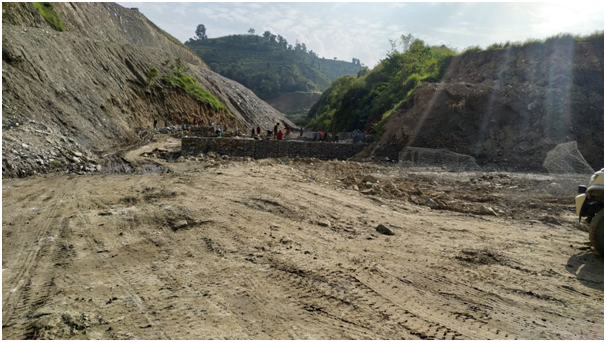
The study revealed that the places namely Tallo Seudeni (just above the landfill site), Khilbucha, Tilkhoriya, Swotibaluwa, Simkhada Gaun, Magatatole, Panchmuritole and Kolpukhola stream are highly affected from the landfill site. Affected places included Bhandara Thumka, Dhoka Bhanjyang, Pathak Gaun, Degaun, Chhauthe, Seudeni (around Shivalaya High School), and Kagati Gaun. The least affected areas included Katunjegaun, Swanagaun, Kagati Gaun (around the health post) and Seudeni Tanki Danda.
The human waste coexistence in and around Sisdol landfill site has created environmental, health and social impacts. Local people are facing numerous problems. They have reported the cases of excessive and intolerable odour during mornings and evenings and during the time of waste transportation. Flies from the landfill site have caused diarrhoea and dysentery. A few local people have even claimed that haphazardly thrown hospital waste has caused cancer and paralysis among them. The dumping of hospital waste has increased the risk of communicable diseases. The locals reported swelling and rashness when they cross the river to reach their agricultural land.
The untreated leachate which has been directly mixed in the Kolpu has not only created environmental problems but has created problems to humans, cattle and in agriculture as well. The cattle including cows, buffaloes, and goats after drinking the leachate- contaminated water have been reported to have fallen sick. A few of the cattle have been reported dead.
The agricultural land irrigated with the leachate-contaminated water decreased the production of paddy, wheat and other crops a result of poor soil quality. The report has shown the presence of heavy metals such as arsenic, iron, copper, cadmium, chromium, lead, and nickel among others in the leachate. Moreover, various pathogenic bacteria have been detected in the leachate as well as in surface and groundwater samples.
The dogs which feed on food materials (mainly decayed meat) dumped in the landfill site have shown changes in their behaviours. They are frequently reported to attack and bite children and women. The dogs and foxes transfer these carcasses around the locality which further spread diseases. The locals even reported that hawks and eagles bring the materials from the landfill site, leave them on their roofs and contaminate the water sources. The contaminated water resource has created problems of water-borne diseases also.
According to the data about the composition of waste in Kathmandu, 63 per cent of the waste is organic, which can be easily managed at the household level through various techniques like composting, and vermicomposting. On the one hand, it would enhance the quality of the soil by replacing the inorganic fertilisers; on the other, it would also increase the lifespan of the landfill site.
Shrestha is an environmental inspector in Jitpur Simara sub-metropolitan city, Bara.




